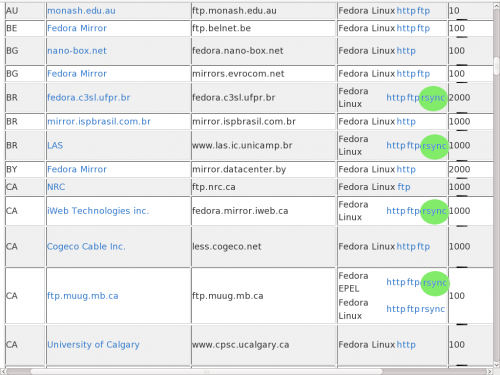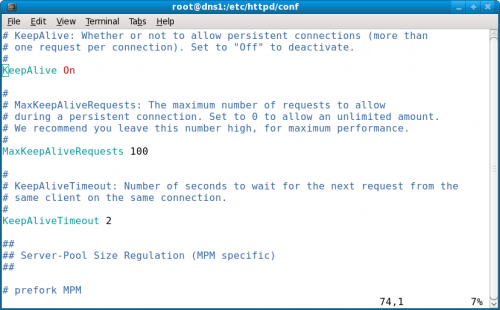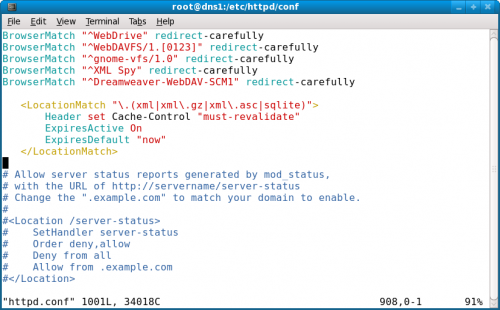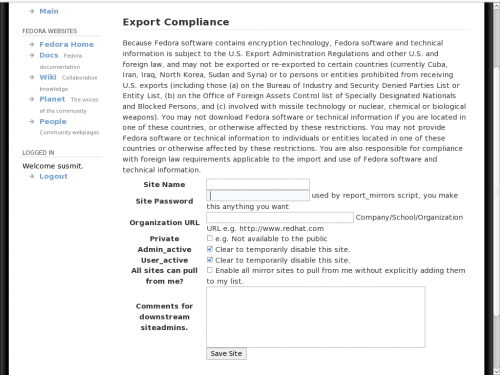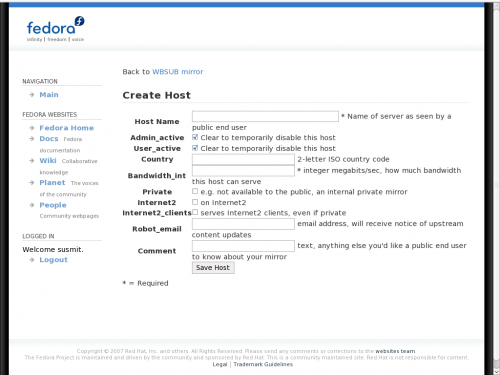(→Registering your mirror: Spelling and grammar fixes) |
(→Conclusion: Spelling and grammar fixes) |
||
| Line 220: | Line 220: | ||
===Subscribe to Mailing Lists === | ===Subscribe to Mailing Lists === | ||
To be notified about the releases and other details, you should subscribe to the http://www.redhat.com/mailman/listinfo/mirror-list announcement list, and http://www.redhat.com/mailman/listinfo/mirror-list-d, which is a discussion list. | To be notified about the releases and other details, you should subscribe to the http://www.redhat.com/mailman/listinfo/mirror-list announcement list, and http://www.redhat.com/mailman/listinfo/mirror-list-d, which is a discussion list. These lists are private, so you need to send an email to mirror-admin AT fedoraproject DOT org with the link to your host in MirrorManager. | ||
=== Further Information === | === Further Information === | ||
| Line 226: | Line 226: | ||
* http://fedorahosted.org/mirrormanager | * http://fedorahosted.org/mirrormanager | ||
If you have questions, comments or suggestions, you can just drop me a mail at [susmit AT fedoraproject DOT org]. | |||
Signing off, Enjoy!!! | Signing off, Enjoy!!! | ||
Revision as of 05:10, 8 August 2009
Mirroring
Introduction
The most common nocturnal activity of an engineering student, particularly when exams are approaching, is to fire up a first person shooter game. Now suppose, the geek in you, fed up with all the trivialities a text book has to offer, decide to challenge your friend to a deadly dual of OpenArena. According to Murphy's Law, he won't have it installed, and the Internet connection will go down at that very moment. Now being a geek, though you are sure that the world is conspiring against you, you won't give up so easily, would you? You will decide to see the end of it by creating a local mirror of the Fedora Linux distribution, so that every package is ready to serve when you want them. Of course you will be able to do it yourself, but I consider it my duty to make it easier so to allow you to take up more important duties like running an OpenArena server.
Now, having read so far, if you are not entirely sure what this is all about, let me tell you: it is about mirroring Fedora repositories within your organization or institute. The benefits: faster downloads for you and your friends, effective use of bandwidth and lowered cost.
According to Wikipedia, In computing, a mirror is an exact copy of a data set. On the Internet, a mirror site is an exact copy of another Internet site. When you try to install a new package into your Fedora installation, either via PackageKit or via yum, they fetch the packages from an Internet site along with the libraries and other software required for it and install it on your computer. Now software like OpenOffice or OpenArena are very big in size and along with all their dependencies, i.e., the other software on which this particular software depends, the download size may be in the order of hundreds of megabytes.
Now consider a simple calculation, if your institute or organisation has 100 users and each downloads OpenOffice separately, it will take around 100x150 = 15000MB of aggregated download. If you consider even a normal usage scenario, where users occasionally install new software and update their system, such downloads can easily reach the terrabyte level per month. In countries like India, where bandwidth is a costly commodity, it is hardly possible for an institute or organisations to invest an astronomical amount for such a huge bandwidth and this can easily play a spoilsport to the advent of FOSS.
The easy solution to this problem is to put up a server inside the institute or organisation, where all the contents are downloaded and updated periodically and users get the software from this local server instead of the Internet. Considering that the cost of bandwidth inside a LAN is trivial and it usually offers much better throughput, mirroring can be an ideal solution to reduce the expenditure and can considerably speed up installations of new software or updates. It can even reduce the need of a physical media, such as CD or DVD as you can use the server for disk-less network installations.
In the subsequent sections, I shall take you through a step by step guide on how to set up a Fedora mirror.
Mirroring Requirements
Hardware
Mirroring does not cost much as far as hardware is concerned. If you are going to mirror the whole Fedora content, at least 1TB of disk space is needed. But if you are not an ISP or a big educational institute, you probably won't need all the contents available in the Fedora repositories. It should be an amicable solution for most of the organisations to keep 32 bit and 64 bit repositories of last two releases, along with their updates. For example, if you are mirroring right now, it would be good to keep 32 bit (generally called as x86) and 64 bit (called as x86_64) repositories of Fedora 10 and 11 along with their updates.
A server with approximate 250GB of hard disk space, though the actual need will depend upon the content you want to keep, and 2-4GB of RAM should do perfectly.
Software
Software requirements for mirroring is also minimal. All you need is an Apache web server or a FTP server. However, please check your version of Apache. If the version is 1.x or 2.0, you will need both the Apache and and FTP server, because earlier Apache servers cannot handle files over 2GB in size, so you have to redirect the iso download requests to FTP server. However, if you are using Apache 2.1 or 2.2, you need not worry about this as large file handling support has been added in these versions. Here, we will show mirroring only using Apache. Mirroring using FTP is similar and need no remarkably different configuration.
Bandwidth
The most essential requirement for mirroring is bandwidth. How long your download will take depends on the available bandwidth. Mirroring over a 5Mbps leased line may take several days for each release being mirrored, but most of these contents need to be downloaded only once. The subsequent downloads will need much less bandwidth, often as minimal as a couple hundred megabytes per day.
If you are trying to be listed as a public mirror of Fedora, by which you want to offer downloads to people outside your organisation, the official bandwidth requirement is 100Mbps. However, in countries like India, where very few public mirrors are available, this requirement is often relaxed. The first public Fedora mirror in India started with a 5Mbps leased line, until other institutes like NIT-H, IIT-M and IIT-K stepped in.
What to mirror?
Though in the previous section I have already suggested that you may choose to mirror the last two releases along with their updates, it obviously depends upon you. The complete list of directories along with their sizes are given at http://download.fedora.redhat.com/pub/DIRECTORY_SIZES.txt . You can choose what to mirror and what not depending upon your organisational or institutional needs.
Public or Private
Another very important step is to decide if you want to make your mirror a public mirror, which serves content to people outside your organisation, or a private mirror, which serves people only inside your organisation. If you don't have large bandwidth, at least ~100Mbps, it is better to go for a private mirror. However, for countries like India, where the number of mirrors are far less than required, you can go public with 15-20 Mbps bandwidth.
Mirroring Procedure
Having finished describing the requirements of mirroring, we now move onto the actual part, which describes how set up a Fedora mirror. Before you get your hands dirty, it would be beneficial if you can study the directory structure of the Fedora repository for a while. You can find it at http://download.fedora.redhat.com/pub/fedora/linux/ .
Synchronising Content
Synchronising content, simply, is copying the contents of a Fedora mirror into your server in such a way that all the properties of the files and directories being transferred remain unchanged. As this is the most time consuming process involving a large number of file downloads, it is suggested that you first get this started and while it pulls content from the server, you do other necessary configurations. The only reliable way to do mirroring is to use rsync, which is an utility for incremental file transfer. Like FTP, rsync also transfers files between a server and a client, but if the file transfer breaks down midway as a result of a network or power outage, it will resume transferring files from the point where it left off. From now on, we shall use the terms synchronise or pull instead of "file transfer".
It is best to set up a new user account on your system which will perform the synchronization.
# useradd -r -m mirror
The directory structure you are mirroring should match that of Fedora's master mirrors. To do so, simply create them and give your mirror user write permissions:
# mkdir -p /var/www/html/pub/fedora/linux/releases
# chown -R mirror:mirror /var/www/html/pub
# find /var/www/html/pub -type d -exec chmod 0755 \{\} \;
If you wish to exclude some content from synchronizing, you will create an exclude.txt file. You may put any expression into that file and when rsync is told about it, rsync won't pull those contents. You'll do this as your new mirror user.
# su - mirror $ touch exclude.txt
An exclude.txt file typically look like this:
$ vi exclude.txt
As you can see you can put regular expressions in the exclude file. It means, you need not put in all the names of the directories which you want to exclude. When you put ppc* in the exclude.txt file, all directories starting with ppc will not be pulled.
Now that we are finished with the exclude part we are ready to pull in the actual content. The rsync command may look like this
$ rsync -vaH --exclude-from=/home/mirror/exclude.txt --numeric-ids --delete --delete-after --delay-updates rsync://mirror.anl.gov/fedora/linux/releases/11 /var/www/html/pub/fedora/linux/releases/
This command will start pulling Fedora 11 repository and put them into /var/www/html/pub/fedora/linux/releases/11.
Now let's see what does this mean. Rsync, as stated earlier, is an incremental file transfer protocol. -v stands for verbose mode, i.e., it will print the outputs in the console while running. -a means archive option, -H means the rsync run will preserve hard links between the files (which saves considerable amounts of disk space and reduces file transfers). Then we define which directories not to synchronise using --exclude-from. the --delete, --delete-after --delay update tells rsync not to delete old contents while synchronising new data. Instead, it tells rsync to keep the old file and directories until the synchronization is complete. Then finally we define the remote rsync server and the destination directory.
If you are worried from which server you want to pull the repositories from, you can get list of servers, which provide rsync service, from the Fedora mirrorlist at http://mirrors.fedoraproject.org/publiclist/ . It would be nice to choose a reliable server near you. Also, don't forget to drop a mail to the admin of the server as a matter of courtesy and also for ensuring there is no planned outage in next couple of days at their end.
Saving some bandwidth
A little trick can save you a few gigabytes of download. If you are not sure about the directory structure Fedora repositories have, be a bit careful about this.
The iso of Fedora DVD resides at Fedora/$architecture/iso/ directory. Also the same contents of the DVD is at Fedora/$architecture/os/, but as extracted files and directories. For example, http://118.102.181.66/releases/11/Fedora/i386/os/ contains the files of http://118.102.181.66/releases/11/Fedora/i386/iso/Fedora-11-i386-DVD.iso. So if you download the .iso file first and then copy the content over to the os/ directory, you need not download the same content twice. Lets see how do we do it.
Once the download of the DVD iso file is completed, mount it somewhere.
# mount -o loop /var/www/html/pub/fedora/linux/releases/11/Fedora/i386/iso/Fedora-11-i386-DVD.iso /mnt # cp -prv /mnt/* /var/www/html/pub/fedora/linux/releases/11/Fedora/i386/os/ # umount /mnt
Similarly, you can repeat for x86_64 DVD iso, if you are mirroring that architecture too.
Just a point to note, be sure to use the -p option with cp. If you don't do it, the copy operation will change the timestamps of the files being copied and rsync will treat them as invalid. Rsync will pull all the content again overwriting the copied files in the process thwarting all your efforts to save bandwidth.
If download stops
In the course of synchronising, it is highly possible that you will receive a few messages like this: Suddenly the Dungeon collapses!! - You die... and the download will stop. Don't panic. Only the rsync has stopped for some reason. Just press the up arrow and enter the same command. Rsync will pick up from where it left off. Also, you won't be able to see any file in the directories until all the content of a directory is pulled. You can assure that the download is indeed happening by using this periodically
# du -m /var/www/html/ | tail -n 1
Other Configurations
Let the rsync run in its own course. You have nothing to do other than periodically checking if it has stopped. In the meantime, let's do other necessary configurations.
Configuring Apache server
Enable Keepalives
Enabling KeepAlive in httpd allows persistent connections. These long-lived HTTP sessions allow multiple requests to be sent over the same TCP connection, and as it does not require separate connection setups for each file. This reduces some overhead and significantly reduces latency times. By default, Fedora's Apache httpd package has keepalives disabled. They should be enabled, with a timeout of 2 seconds. Don't keep this very high, it may overload your server.
Handling of metadata
Metadata are typically defined as "data about data". When you try to install a package or update a system, first things which get downloaded is package metadata. These are files with information about the packages, their age and other details. Now, for example, if a computer has old metadata cached, according to which all the packages are up-to-date, no new updates will be installed into the system. To work around this, we explicitly add Cache Control: must-revalidate option which insists that yum or any client must revalidate the metadata against the server before serving it from cache. For this, add the following section to your /etc/httpd/conf/httpd.conf around the <Location> directive (around line 900).
<LocationMatch "\.(xml|xml\.gz|xml\.asc|sqlite)">
Header set Cache-Control "must-revalidate"
ExpiresActive On
ExpiresDefault "now"
</LocationMatch>
Content Types
ISO and RPM files should be served using MIME Content-Type: application/octet-stream. In Apache, this can be done inside a VirtualHost or similar section:
<VirtualHost *:80> AddType application/octet-stream .iso AddType application/octet-stream .rpm </VirtualHost>
Limiting Download Accelerators
Download accelerators will try to open the same file many times, and request chunks, hoping to download them in parallel. This can overload heavily loaded mirror servers, and cause a denial of service.
To limit connections to ISO dirs by some amount per IP:
<IfModule mod_limitipconn.c> MaxConnPerIP 3 </IfModule>
To block ranged requests as this is what download accelerators do indeed:
RewriteEngine on
RewriteCond %{HTTP:Range} [0-9] $
RewriteRule \.iso$ / [F,L]
Restart Apache
Now restart Apache. If everything is fine, you should not get an error. If you can start the Apache server successfully, it means you are done with most of the things.
Registering your mirror
Now that your configuration is almost done, you must register your mirror, regardless it is a private mirror or a public mirror.
Get a Fedora Account
Firstly, you need to go to https://admin.fedoraproject.org/accounts/ and get yourself a Fedora account. Without this, you can not proceed further. However, you may choose to not sign the Fedora Contributor License Agreement (CLA), which is not required if you only want to be a mirror administrator. Please do consider signing the CLA, as other contributions to Fedora do require it, and with all the fun you're having as a mirror administrator, you may find other aspects of Fedora you want to join as well.
Register your Mirror
At this point, let me introduce MirrorManager, the database which automatically keeps track of the mirrors. Go to https://admin.fedoraproject.org/mirrormanager/ and login with the credentials you just created. Here you need to do only two things.
First, create a site using the link [Add Site] under My Sites and Hosts. What you need to put into the fields are explained beside the fields and are self-explanatory.
Once you fill in the form and save the site, you will find a new link My Hosts. Now add a host to it. The difference between host and site is: a site is the details of the parent organisation, e.g. an university, while host is the details of the individual machines hosting the Fedora repositories, e.g., a server. Obviously, a site can have multiple hosts.
You can restrict your mirror within the organisation using the Private checkbox. Once you save the host, you will have a few more options to fine tune your mirror. One particularly unique feature of MirrorManager is the ability to specify a list of network addresses (netblocks) which belong to each organization. By adding your organization's netblock delegation to the database, MirrorManager will automatically direct all users coming from within that netblock to your mirror, with no configuration changes necessary on the part of the user. For example, if your organisation has the public IP range, just for example,from 118.102.161.66 to 118.102.161.96 and it has a subnet mask 255.255.255.224, that means you need to enter 118.102.161.64/27 as your netblock.
Run report_mirror
Now, your site and the host is created, it is time to inform the MirrorManager database about your mirror contents. For this, you need to install mirrormanager-client. You can do it very easily using:
# yum -y install mirrormanager-client
You need to edit a configuration file minimally. Once the installation is done, you will find the configuration file under /etc/mirrormanager-client/report_mirror.conf. Edit it suitably to reflect the contents and the paths of your mirror.
[global] # if enabled=0, no data is sent to the database enabled=1 server=https://admin.fedoraproject.org/mirrormanager/xmlrpc
[site] # if enabled=0, no data about this site is sent to the database enabled=1 name=WBSUB mirror password=*****
[host] # if enabled=0, no data about this host is sent to the database enabled=1 name=118.102.181.66
[Fedora Linux] enabled=1 path=/var/www/html/pub/fedora/linux #replace this with your path_to_content
You will find more categories under this. If you have these contents, set enabled=1 or set enabled=0. You can also delete them without problem.
Once this far is done, run report_mirror script using
$ /usr/bin/report_mirror -c /etc/mirrormanager-client/report_mirror.conf
Once successfully completed, it will show "Checked in successfully". You can now see the contents of your mirror under your mirrormanager host. You should run report_mirror following each successful rsync run.
Conclusion
Congratulations!!! You have successfully finished mirroring Fedora. Also, you have acquired a rare set of practical skills in the process. It is time to celebrate, but don't forget a few complimentary things which are yet to be done.
Subscribe to Mailing Lists
To be notified about the releases and other details, you should subscribe to the http://www.redhat.com/mailman/listinfo/mirror-list announcement list, and http://www.redhat.com/mailman/listinfo/mirror-list-d, which is a discussion list. These lists are private, so you need to send an email to mirror-admin AT fedoraproject DOT org with the link to your host in MirrorManager.
Further Information
If you have questions, comments or suggestions, you can just drop me a mail at [susmit AT fedoraproject DOT org].
Signing off, Enjoy!!!


